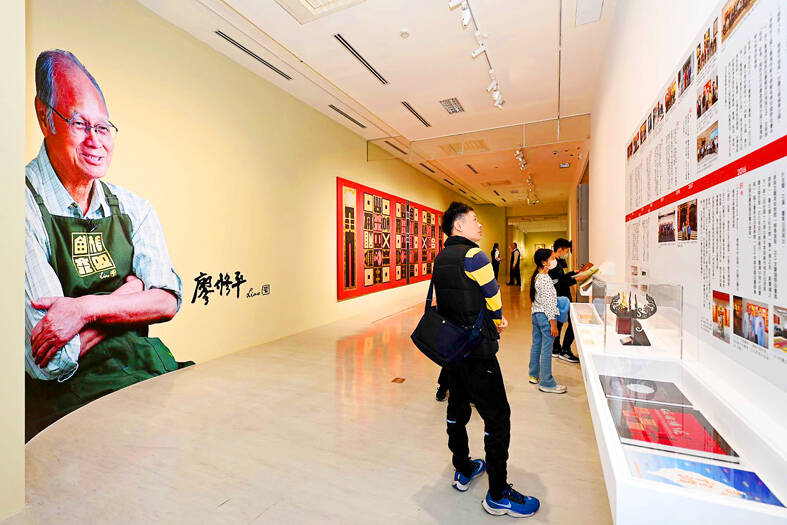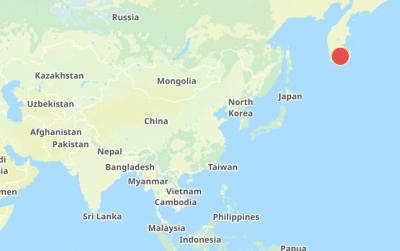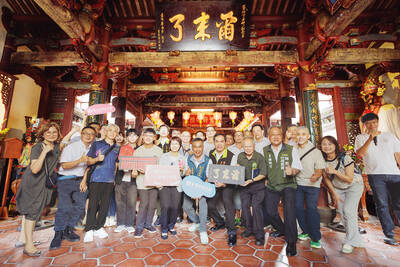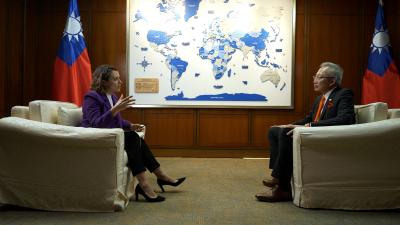An exhibition on the work and life of artist Liao Hsiou-ping (廖修平), known as the “godfather of modern Taiwanese woodblock printing,” is being held at the National Taiwan Museum of Fine Arts until June 29.
The exhibition, which opened on March 22, is divided into three areas documenting Liao’s works as a student, artist and teacher.
Along with Liao’s woodblock print pieces, which he is best known for, the exhibition also showcases his sculptures and oil paintings.

Photo courtesy of the National Taiwan Museum of Fine Arts
Stressing the importance of artistic originality, Liao, a chair professor at National Taiwan Normal University, said he has always encouraged his students to explore and develop their own unique styles, and not let his lessons interfere with their creative processes.
Hsiao Chong-ray (蕭瓊瑞), who curated the exhibition, said Liao’s works often blend tradition with modernity, fantasy with reality, and grandeur with isolation.
That helps visitors feel happy and calm, Hsiao said.
Liao was born in Taipei in 1936. From an early age, he observed his father and older brother, both architects, drawing blueprints.
While growing up near Longshan Temple (龍山寺) in Taipei’s Wanhua District (萬華), Liao became fascinated with the ornate paintings and patterns on the temple. These early influences came to have a profound impact on his artistic style.
Liao traveled to Japan to study painting in 1962, where he was introduced to woodblock printing. He moved to France to study at the Beaux-Arts de Paris in 1965.
In 1969, he was commissioned to hold an exhibition at the Miami Museum of Contemporary Art. He then moved to New York, before returning to Taiwan in 1973.
Liao gained international recognition for his distinctive style that blends traditional Taiwanese elements with woodblock printing, elevating the global profile of Taiwanese woodblock art in the process.

The Central Weather Administration (CWA) today issued a "tsunami watch" alert after a magnitude 8.7 earthquake struck off the Kamchatka Peninsula in northeastern Russia earlier in the morning. The quake struck off the east coast of the Kamchatka Peninsula at 7:25am (Taiwan time) at a depth of about 19km, the CWA said, citing figures from the Pacific Tsunami Warning Center. The CWA's Seismological Center said preliminary assessments indicate that a tsunami could reach Taiwan's coastal areas by 1:18pm today. The CWA urged residents along the coast to stay alert and take necessary precautions as waves as high as 1m could hit the southeastern

The National Museum of Taiwan Literature is next month to hold an exhibition in Osaka, Japan, showcasing the rich and unique history of Taiwanese folklore and literature. The exhibition, which is to run from Aug. 10 to Aug. 20 at the city’s Central Public Hall, is part of the “We Taiwan” at Expo 2025 series, highlighting Taiwan’s cultural ties with the international community, National Museum of Taiwan Literature director Chen Ying-fang (陳瑩芳) said. Folklore and literature, among Taiwan’s richest cultural heritages, naturally deserve a central place in the global dialogue, Chen said. Taiwan’s folklore would be immediately apparent at the entrance of the

“China is preparing to invade Taiwan,” Deputy Minister of Foreign Affairs Francois Wu (吳志中) said in an exclusive interview with British media channel Sky News for a special report titled, “Is Taiwan ready for a Chinese invasion?” the Ministry of Foreign Affairs said today in a statement. The 25-minute-long special report by Helen Ann-Smith released yesterday saw Sky News travel to Penghu, Taoyuan and Taipei to discuss the possibility of a Chinese invasion and how Taiwan is preparing for an attack. The film observed emergency response drills, interviewed baseball fans at the Taipei Dome on their views of US President

Speeding and badly maintained roads were the main causes of a school bus accident on a rainy day in Taipei last year that severely injured two people and left 22 with minor injuries, the Taiwan Transportation and Safety Board said. On March 11 last year, a Kang Chiao International School bus overturned inside the Wenshan Tunnel (文山隧道) on the northbound lane of the Xinyi Expressway. The tour bus, owned by Long Lai Co, exceeded the speed limit after entering the tunnel, the board’s investigation found. Sensing that the rear of the vehicle was swaying, the driver attempted to use the service and exhaust